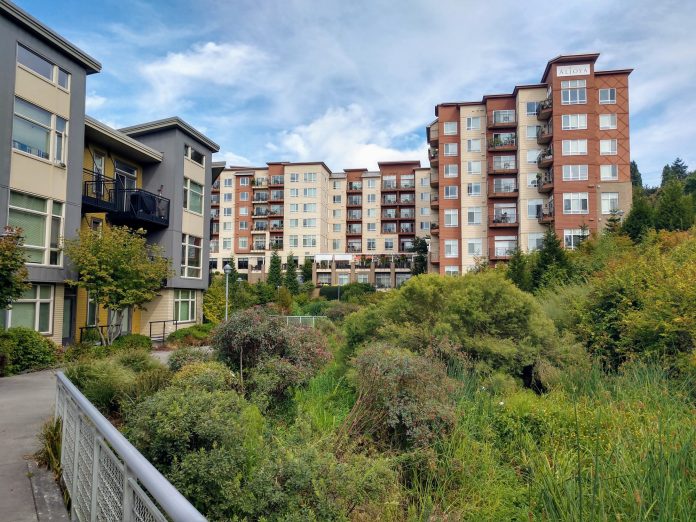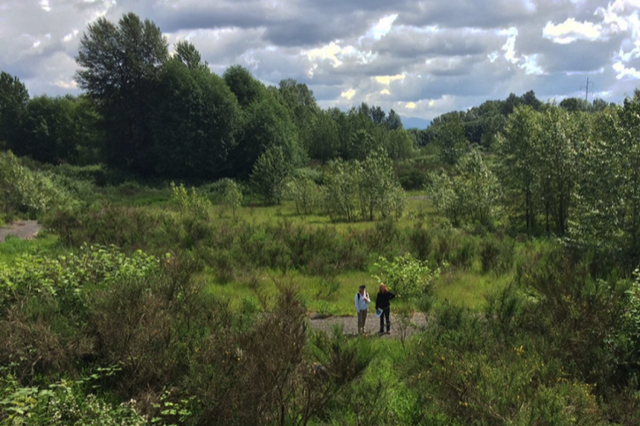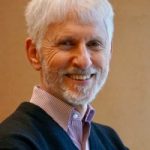
Seattle’s green urban assets are worth billions and valuing them could protect them.
Thanks to Covid-19 and the West Seattle Bridge closure, the air is so clear that from Alki Beach, you can see the colors of trees and houses on Magnolia. The 55% drop in Seattle’s weekday traffic has cut CO2 and smog-related nitrogen oxide levels by more than 15%, according to the Seattle Department of Transportation (SDOT).
But a public health crisis is not a sustainable way to decrease pollution. It may put a micro-dent in the Keeling Curve. But in a city that has been ranked one of America’s ten worst heat islands and sixth worst traffic congestion (and pollution), building up Seattle’s long-term pollution reducers–trees, green spaces, and aquatic habitats–would put us on a more sustainable course.
While Seattle is noisily driving, building, and manufacturing, our underappreciated green assets are quietly making oxygen, absorbing pollutants, sponging up stormwater and controlling erosion. They’re also enhancing property values, supporting urban fisheries, agriculture and recreation, animal habitats, and pollinator corridors. And they’re helping improve mental health and longevity. About 30 years ago, economists realized those benefits and savings–-“ecosystem services” are worth big money–more than $33 trillion a year according to Robert Costanza et al. in their estimate of the planet’s biosphere value. That’s nearly $54 trillion in 2020 dollars.
The Seattle Green Spaces Coalition (SGSC) reckons that, within Seattle’s 142.5 square miles of land and water, our “natural capital” provides more than $3 billion a year in benefits and savings. While our city doesn’t account for that as an asset, King County has. In 2000, it used ecosystem services valuation (ESV), which estimates the worth to cities and towns of fisheries, habitats, agriculture, and recreation space, to design its Duwamish River watershed salmon protection plan. Then in 2001, Seattle Public Utilities used ESV in restoring Thornton Creek. The Urban Forestry Commission, in 2008, set a goal to cover 35% of Seattle with trees by 2035 (since revised downward to 30% by 2037), and drafted guidelines for an updated tree protection ordinance. Despite widespread public support, the City Council has not passed an update, leaving nine uncoordinated city agencies to protect Seattle’s trees–and no clear plan for expanding green urban assets.
In 2010, visionary Seattle Parks director Tim Gallagher hired the Trust For Public Lands to assess the natural capital value of Seattle’s parks. It found their land and water resources provided nearly $500 million a year worth of benefits and savings, dwarfing the $30,000 a year Parks was making in fees and rentals. When Gallagher presented the surprising report to Seattle’s City Council, members marveled, had no idea how to integrate those dollars into City accounting, and cut the parks budget amid the recession.
Parks occupy barely 11% of Seattle’s land and water area. Multiplying their $500 million value by nine for the rest of Seattle’s area, including carbon-absorbent water, and knowing that nearly 70% of Seattle’s trees and other flora grow on private and other properties, SGSC reckoned that our natural capital is worth about $3 billion a year to the city.
But the City’s finance department, Mayor, City Council and private sector still do not account for the value of natural capital. It’s a “soft” asset they see as an overhead cost, not a hard asset like grey infrastructure–roads, buildings, and vehicles that generate revenue. They still can’t conceive of how to account for green infrastructure. The following sums up their attitudes:
- “Exceptional trees must be retained unless doing so would prohibit meeting the zone potential of the site,” city planner Brennon Staley said at a University of Washington Urban Forestry Conference in May 2010.
- The Master Builders Association opposes building setbacks to make room for trees and landscapes, unless they contribute to views and property value, while Vulcan and other developers see bio-swales (street-side rainwater catchment corrals) as “green spaces.”
- After the Seattle City Council’s unanimous 2015 vote to study natural capital, former Deputy Mayor Steve Lee fretted: “There could be policy implications here.”
In 2014, a group of West Seattle neighbors founded SGSC, to keep public lands in public hands for public benefit. The City of Seattle owns hundreds of acres of non-parkland–from hillsides to street ends and parking strips, to Seattle City Light (SCL) substations. When departments have no further use for property they own, they declare it “excess,” and/or “surplus,” offer it to other departments, and if there are no takers, the City Council approves it for sale at fair market value.
Seattle recognizes only one way to value land: real estate appraisal. Residential and commercial developments grow its tax base. This private ownership model dates from the Agricultural Revolution in the Fertile Crescent 10,000 years ago, when hunter-gatherer humans settled down, and started claiming spaces to grow food, herd livestock, and exploit resources. While Coast Salish and Duwamish nations had been living harmoniously with nature for thousands of years in Seattle, White colonists since the 1800s have imposed the private property model to forcibly remove them, commodify nature and amass wealth. Today, all Seattle land is owned, and Nature is elbowed aside.
SGSC asserts that where the City owns green space, it should keep it, not sell it. It’s cheaper than having to buy it back at higher future prices to replace it. So SGSC supported Delridge Neighborhood Development Association buying and converting SCL’s Delridge substation into a wetland education center for STEM schools. SGSC helped Lake Forest Park buy and transform five acres of Seattle Public Utilities forest into a city park. SGSC supports the Urban Homestead Foundation’s SCL Dakota project. And rallying a dozen organizations and nearly 1,500 petition signers across Seattle, SGSC helped convince the Murray administration in July 2016 to keep the 33-acre Myers Parcels forest and wetland as a land bank for a future Seattle park, not sell it.

At SGSC’s urging, ecosystem economist David Batker, testified September 28, 2015 to the City Council (see 36:35 in video) in support of valuing ecosystem services. Batker worked on the Thornton Creek watershed, and state, national, and international projects.
Batker cited the Cedar River Watershed, which Seattle’s 1891 City Council bought. Its 91,000 forested acres have supplied trillions of gallons of fresh water to millions of Seattle area residents for more than 120 years. It’s a priceless asset that’s given us vast public health, recreational, environmental, and livability benefits. But if it were declared surplus, it would be sold at “fair market value” as raw land. “There’s something wrong with the accounting here,” said Batker.
The nine City Council members unanimously approved a Statement of Legislative Intent (SLI 75-1-A-2 2015, written by council staffer Lisa Herbold for then-Councilmember Licata), to study how natural capital value could be assessed and used for the city’s benefit. No SLI is binding, but a project scope was outlined, and a consultant designated. City Council and Facilities and Administrative Services (FAS) staffs wrote response papers, and the Mayor weighed in.
But some environmentalists said valuing the environment would (1) commodify it, (2) undercut the compelling intrinsic value argument for nature, and (3) make property rights an issue. Actually, the natural world has been commodified for 10,000 years, the intrinsic value argument hasn’t stopped species extinctions or forest depletion, and property rights help people pretend that a fence around a parcel means it’s no longer part of Earth. These environmentalists preferred land-swapping buildable urban property for unbuildable rural land–an exchange that perpetuates depletion of urban natural capital.
Housing advocates said wilderness and housing couldn’t coexist, though they do across Seattle. Private interests worried if natural capital were valued beyond the costs of landscape plants, or the price boost that views give real estate, it would hamper development, increase project costs, and cause enforcement headaches. And in 2015, standard accounting structures like GAAP (Generally Accepted Accounting Principles) and GASB (Government Accounting Standards Board) had no rules for valuing and accounting for natural capital. Today, both GAAP and GASB are developing those rules.
SGSC continued urging the City Council to fund a natural capital consultant. And dozens of allies came forward, including PCC Natural Markets, R.E.I., TreePac, Tilth Alliance, GROW, the Duwamish Tribal Council, Sustainable Seattle, Groundswell Northwest, Interfaith Power & Light, and more. And in Seattle’s 2020 budget, the City Council approved $35,000 for a consultant.
While valuing natural capital may add a layer of complexity to land appraisal, it will create a more balanced approach to development, urban design, and Seattle’s growth. It would stop city agencies and developers from treating every parcel as separate and ecologically insignificant, and require treating each one as part of Seattle’s total ecosystem.
Accounting for ESV would take bold action, but Seattle has often been bold. It led North America with its green waste and recycling programs in 1988. Its 2005 Mayor’s Climate Protection Initiative has now been co-signed by 1,066 mayors representing more than 65% of the U.S. population. By taking the lead here, Seattle can show cities and towns across North America how to improve livability, sustainability, resilience and equity, if they treat our priceless, yet unaccounted for capital as an asset.

Martin Westerman (Guest Contributor)
Martin Westerman has authored two environmental business books and dozens of articles, taught green business and communications at the UW Foster School of Business from 2000 to 2008, and currently serves on the boards of the the Seattle Green Spaces Coalition and the West Seattle Transportation Coalition. He lives in West Seattle.
